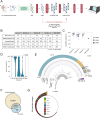Improved SARS-CoV-2 sequencing surveillance allows the identification of new variants and signatures in infected patients
- PMID: 35962405
- PMCID: PMC9372932
- DOI: 10.1186/s13073-022-01098-8
Improved SARS-CoV-2 sequencing surveillance allows the identification of new variants and signatures in infected patients
Abstract
Background: Genomic surveillance of severe acute respiratory syndrome coronavirus 2 (SARS-CoV-2) is the only approach to rapidly monitor and tackle emerging variants of concern (VOC) of the COVID-19 pandemic. Such scrutiny is crucial to limit the spread of VOC that might escape the immune protection conferred by vaccination strategies or previous virus exposure. It is also becoming clear now that efficient genomic surveillance would require monitoring of the host gene expression to identify prognostic biomarkers of treatment efficacy and disease progression. Here we propose an integrative workflow to both generate thousands of SARS-CoV-2 genome sequences per week and analyze host gene expression upon infection.
Methods: In this study we applied an integrated workflow for RNA extracted from nasal swabs to obtain in parallel the full genome of SARS-CoV-2 and transcriptome of host respiratory epithelium. The RNA extracted from each sample was reverse transcribed and the viral genome was specifically enriched through an amplicon-based approach. The very same RNA was then used for patient transcriptome analysis. Samples were collected in the Campania region, Italy, for viral genome sequencing. Patient transcriptome analysis was performed on about 700 samples divided into two cohorts of patients, depending on the viral variant detected (B.1 or delta).
Results: We sequenced over 20,000 viral genomes since the beginning of the pandemic, producing the highest number of sequences in Italy. We thus reconstructed the pandemic dynamics in the regional territory from March 2020 to December 2021. In addition, we have matured and applied novel proof-of-principle approaches to prioritize possible gain-of-function mutations by leveraging patients' metadata and isolated patient-specific signatures of SARS-CoV-2 infection. This allowed us to (i) identify three new viral variants that specifically originated in the Campania region, (ii) map SARS-CoV-2 intrahost variability during long-term infections and in one case identify an increase in the number of mutations in the viral genome, and (iii) identify host gene expression signatures correlated with viral load in upper respiratory ways.
Conclusion: In conclusion, we have successfully generated an optimized and cost-effective strategy to monitor SARS-CoV-2 genetic variability, without the need of automation. Thus, our approach is suitable for any lab with a benchtop sequencer and a limited budget, allowing an integrated genomic surveillance on premises. Finally, we have also identified a gene expression signature defining SARS-CoV-2 infection in real-world patients' upper respiratory ways.
© 2022. The Author(s).
Conflict of interest statement
Davide Cacchiarelli and Andrea Ballabio are founders, shareholders, and consultants of Next Generation Diagnostic srl. Patrizia Annunziata, Anna Manfredi, Michela Daniele, Chiara Colantuono and Marcello Salvi are employees or consultants at Next Generation Diagnostic srl. The remaining authors declare that they have no competing interests.
Figures




References
-
- Rambaut A, et al. Preliminary genomic characterisation of an emergent SARS-CoV-2 lineage in the UK defined by a novel set of spike mutations. Virological.org. https://virological.org/t/preliminary-genomic-characterisation-of-an-eme.... Accessed 10 May 2022.
Publication types
MeSH terms
Substances
LinkOut - more resources
Full Text Sources
Medical
Molecular Biology Databases
Miscellaneous

